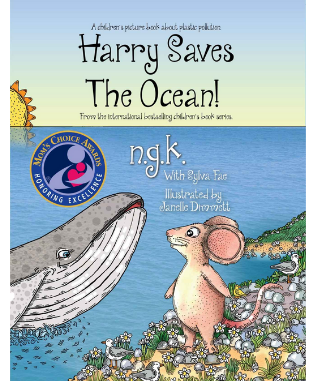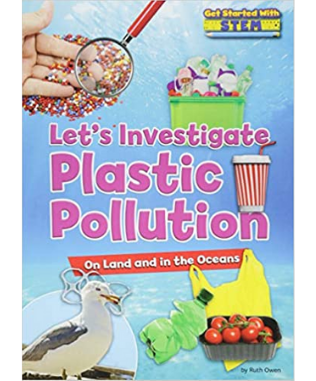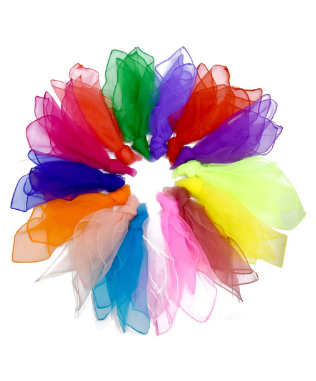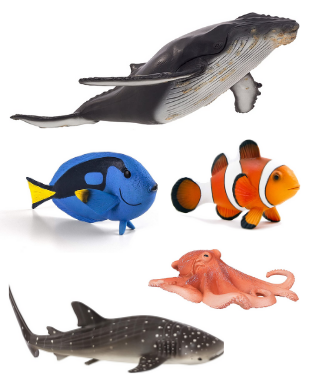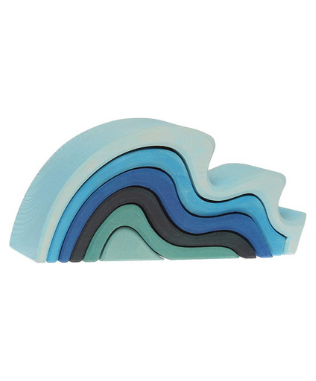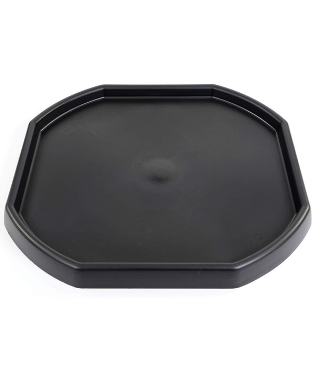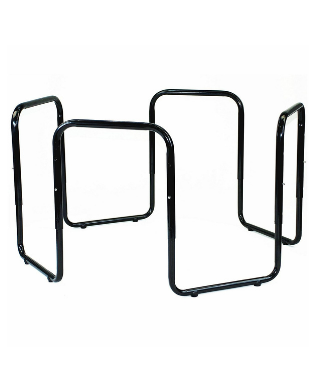Having previously done a lot of ocean life small world play and looked at food chains, Ioan and Finn were very concerned about how plastic pollution was destroying natural habitats in the ocean. We even had a few tears as they talked together about how different habitats normally provide for the basic needs of different kinds of sea animals and plants. With the plastic pollution, all the plastic was affecting the ecosystem, meaning their needs weren’t being met.
Resources
- Harry saves the ocean written by N.G.K. and Sylva Fae, illustrated by Janelle Dimmett
- Let’s investigate plastic pollution on land and in the ocean by Ruth Owen
- Sea creatures
- Plastic rubbish we had been collecting
- M&S Little Shop food items
- Coloured circus scarves
- Grimm’s waterwaves
Method
After reading the book, the boys set up their own Harry Saves The Ocean tray. We then went on to look at the marine ecosystem.
An ecosystem is a community of interacting organisms and their environment. Living things interact with each other and also with non-living things like soil, water and air. The organisms in the ecosystem depend on each other to survive. If their environment changes, that can sometimes pose danger to living things.
We also looked at the non-fiction book, Let’s investigate plastic pollution. They were shocked to see real images of plastic pollution in the oceans, they started reflecting what they had seen in their small world play.
As always, the boys weren’t satisfied with a basic understanding of an ecosystem, so decided to research further. The first thing Ioan discovered was that an ecosystem is made up of two inseparable components:
- The biotope (abiotic): a particular physical environment with specific physical characteristics such as the climate, temperature, humidity, concentration of nutrients or pH.
- The biocenosis (biotic): a set of living organisms such as animals, plants or micro-organisms, that are in constant interaction and are, therefore, in a situation of interdependence.
Together with freshwater ecosystems, marine ecosystems are also part of the broader category of aquatic ecosystems. Marine ecosystems cover more than 70% of the Earth’s surface and have a high salt content. We learnt a lot about this from a National Geographic article, Climate 101:Oceans.
In a marine ecosystem, the biotic components are organisms and their species, predators, parasites, and competitors. On the contrary, the concentration of nutrients, the temperature, sunlight, turbulence, salinity and density are its abiotic components. Natural ecosystems are “balanced” systems. This means the interactions between the different organisms that make up the ecosystem contribute to a certain stability.
A climatic or natural phenomenon, for example plastic pollution, can lead to transformations in the environment. This forces the ecosystem’s living organisms to adapt to these new constraints, and change happens. The various natural imbalances tend to offset each other permanently. Some ecosystems evolve very slowly while others can transform very quickly. Sometimes, in extreme cases, they can even disappear.
Human impact
Like all other living beings, humans are dependant on natural ecosystem services to survive. We need it to get the food we eat, the water we drink and to transform raw materials into our everyday products. So in order to keep our living conditions, it’s truly important that we preserve natural ecosystems.
Human activities are having a negative impact on ecosystems. All our demands for food, water, food, timber, and other materials, have been highly contributing to:
- deforestation
- the loss of natural pollination
- water pollution
- soil exploitation due to intensive agriculture
- overfishing
Renewable and non-renewable resources
A non-renewable resource (also called a finite resource) is a natural resource that cannot be readily replaced by natural means at a quick enough pace to keep up with consumption. Finite resources from the Earth’s crust, oceans and atmosphere will one day run out. They can be processed to provide energy and useful materials, e.g. crude oil, coal, natural gas and other items produced from fossil fuels. No mechanisms exist at present to replenish them.
Renewable resources are those which will not run out in the foreseeable future. Renewable resources are commodities such as solar energy, oxygen, biomass, fish stocks or forestry that is inexhaustible or replaceable over time providing that the rate of extraction of the resource is less than the natural rate at which the resource renews itself.
Circular economy model
We need to rethink the processes by which we change, take, use and dispose of natural resources. They need to become more efficient and circular so that ecosystems can be better preserved. A circular economy model aims to close the gap between the production and the natural ecosystems’ cycles, on which humans ultimately depend upon. This means, on one hand, eliminating waste by composting biodegradable waste or, if it’s a transformed and non-biodegradable waste, reusing, remanufacturing and finally recycling it. On the other hand, it also means cutting off the use of chemical substances (a way to help regenerate natural systems) and increasing use of renewable energy. We found an article about circular economy.
After thinking about the impact of pollution on their ocean scene, the boys did picked up of all the plastics in their marine ecosystem tray, then recycled them. These were the before and after pictures:
We decided we all need to restore a more harmonious and lasting cohabitation with natural habitats and their ecosystems, in order to all benefit from the Earth resources. For more information on ecosystems, read this article by youmatter.
DfES Outcomes for EYFS and National Curriculum (2013)
Science Year 1 programme of study
Animals, including humans
- identify and name a variety of common animals including fish, amphibians, reptiles, birds and mammals
- identify and name a variety of common animals that are carnivores, herbivores and omnivores
- describe and compare the structure of a variety of common animals (fish, amphibians, reptiles, birds and mammals, including pets)
Science Year 2 programme of study
Living things and their habitats
- explore and compare the differences between things that are living, dead, and things that have never been alive
- identify that most living things live in habitats to which they are suited and describe how different habitats provide for the basic needs of different kinds of animals and plants, and how they depend on each other
- identify and name a variety of plants and animals in their habitats, including micro-habitats
- describe how animals obtain their food from plants and other animals, using the idea of a simple food chain, and identify and name different sources of food.
Science Year 4 programme of study
Living things and their habitats
- recognise that environments can change and that this can sometimes pose dangers to living things.
















